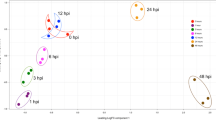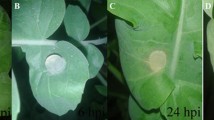Abstract
Sclerotinia sclerotiorum is a necrotrophic plant pathogen which causes serious disease in agronomically important crop species. The molecular basis of plant defense to this pathogen is poorly understood. We investigated gene expression changes associated with S. sclerotiorum infection in a partially resistant and a susceptible genotype of oilseed Brassica napus using a whole genome microarray from Arabidopsis. A total of 686 and 1,547 genes were found to be differentially expressed after infection in the resistant and susceptible genotypes, respectively. The number of differentially expressed genes increased over infection time with the majority being up-regulated in both genotypes. The putative functions of the differentially expressed genes included pathogenesis-related (PR) proteins, proteins involved in the oxidative burst, protein kinase, molecule transporters, cell maintenance and development, abiotic stress, as well as proteins with unknown functions. The gene regulation patterns indicated that a large part of the defense response exhibited as a temporal and quantitative difference between the two genotypes. Genes associated with jasmonic acid (JA) and ethylene signal transduction pathways were induced, but no salicylic acid (SA) responsive genes were identified. Candidate defense genes were identified by integration of the early response genes in the partially resistant line with previously mapped quantitative trait loci (QTL). Expression levels of these genes were verified by Northern blot analyses. These results indicate that genes encoding various proteins involved in diverse roles, particularly WRKY transcription factors and plant cell wall related proteins may play an important role in the defense response to S. sclerotiorum disease.





Similar content being viewed by others
Abbreviations
- ET:
-
Ethylene
- hpi:
-
Hours post-inoculation
- JA:
-
Jasmonic acid
- RT-PCR:
-
Reverse-transcriptase polymerase chain reaction
- SA:
-
Salicylic acid
References
Ali GS, Reddy VS, Lindgren PB, Jakobek JL, Reddy ASN (2003) Differential expression of genes encoding calmodulin-binding proteins in response to bacterial pathogens and inducers of defense responses. Plant Mol Biol 51:803–815
Altschul SF, Gish W, Miller W, Myers EW, Lipman DJ (1990) Basic local alignment search tool. J Mol Biol 215:403–410
Benjamini Y, Hochberg Y (1995) Controlling the false discovery rate: a practical and powerful approach to multiple testing. J R Stat Soc Ser B 57:289–300
Campbell EJ, Schenk PM, Kazan K, Penninckx IAMA, Anderson JP, Maclean DJ, Cammue BPA, Ebert PR, Manners JM (2003) Pathogen-responsive expression of a putative ATP-binding cassette transporter gene conferring resistance to the diterpenoid sclareol is regulated by multiple defense signaling pathways in Arabidopsis. Plant Physiol 133:1272–1284
Cavell AC, Lydiate DJ, Parkin IA, Dean C, Trick M (1998) Collinearity between a 30-centimorgan segment of Arabidopsis thaliana chromosome 4 and duplicated regions within the Brassica napus genome. Genome 41:62–69
Chen W, Provart NJ, Glazebrook J, Katagiri F, Chang HS, Eulgem T, Mauch F, Luan S, Zou G, Whitham SA, Budworth PR, Tao Y, Xie Z, Chen X, Lam S, Kreps JA, Harper JF, Si-Ammour A, Mauch-Mani B, Heinlein M, Kobayashi K, Hohn T, Dangl JL, Wang X, Zhu T (2002) Expression profile matrix of Arabidopsis transcription factor genes suggests their putative functions in response to environmental stresses. Plant Cell 14:559–574
Cheong YH, Chang HS, Gupta R, Wang X, Zhu T, Luan S (2002) Transcriptional profiling reveals novel interactions between wounding, pathogen, abiotic stress, and hormonal responses in Arabidopsis. Plant Physiol 129:661–677
Cleveland WS (1979) Robust locally weighted regression and smoothing scatterplots. J Am Stat Assoc 74:829–836
Craig BA, Black MA, Doerge RW (2003) Gene expression data: the technology and statistical analysis. J Agri Biol Environ Stat (JABES) 8:1–28
Dong X (1998) SA, JA, ethylene, and disease resistance in plants. Curr Opin Plant Biol 1:316–323
Dowd C, Wilson IW, McFadden H (2004) Gene expression profile changes in cotton root and hypocotyl tissues in response to infection with Fusarium oxysporum f. sp. vasinfectum. Mol Plant Microbe Interact 17:654–667
Ferreira ME, Williams PH, Osborn TC (1994) RFLP mapping of Brassica napus using doubled haploid lines. Theor Appl Genet 89:615–621
Feys BJ, Parker JE (2000) Interplay of signaling pathways in plant disease resistance. Trends Genet 16:449–455
Fotopoulos V, Gilbert MJ, Pittman JK, Marvier AC, Buchanan AJ, Sauer N, Hall JL, Williams LE (2003) The monosaccharide transporter gene, AtSTP4, and the cell-wall invertase, Atβfruct1, are induced in Arabidopsis during infection with the fungal biotroph Erysiphe cichoracearum. Plant Physiol 132:821–829
Girke T, Todd J, Ruuska S, White J, Benning C, Ohlrogge J (2000) Microarray analysis of developing Arabidopsis seeds. Plant Physiol 124:1570–1581
Glazebrook J (2005) Contrasting mechanisms of defense against biotrophic and necrotrophic pathogens. Annu Rev Phytopathol 43:205–227
Horvath DP, Schaffer R, West M, Wisman E (2003) Arabidopsis microarrays identify conserved and differentially expressed genes involved in shoot growth and development from distantly related plant species. Plant J 34:125–134
Jasinski M, Ducos E, Martinoia E, Boutry M (2003) The ATP-binding cassette transporters: structure, function, and gene family comparison between rice and Arabidopsis. Plant Physiol 131:1169–1177
Jiang H (2004) A two-step procedure for multiple pairwise comparisons in microarray experiments. Ph.D. Dissertation, Department of Statistics, Purdue University, West Lafayette, IN
Kachroo A, Kachroo P (2007) Salicylic acid-, jasmonic acid- and ethylene-mediated regulation of plant defense signaling. Genetic engineering: principles and methods. Plenum, New York, pp 28:55–75
Lee H, Wang J, Tian L, Jiang H, Black M, Madlung A, Watson B, Lukens, Pires JC, Wang J, Comai L, Osborn TC, Doerge RW, Chen J (2004) Sensitivity of 70-mer oligonucleotides and cDNAs for microarray analysis of gene expression in Arabidopsis and its related species. Plant Biotechnol J 2:45–57
Maleck K, Levine A, Eulgem T, Morgan A, Schmid J, Lawton KA, Dangl JL, Dietrich RA (2000) The transcriptome of Arabidopsis thaliana during systemic acquired resistance. Nat Genet 26:403–410
Marathe R, Guan Z, Anandalakshmi R, Zhao H, Dinesh-Kumar SP (2004) Study of Arabidopsis thaliana resistome in response to cucumber mosaic virus infection using whole genome microarray. Plant Mol Biol 55:501–520
Martinez C, Blanc F, Le Claire E, Besnard O, Nicole M, Baccou J-C (2001) Salicylic acid and ethylene pathways are differentially activated in melon cotyledons by active or heat-denatured cellulase from Trichoderma longibrachiatum. Plant Physiol 127:334–344
McDowell JM, Dangl JL (2000) Signal transduction in the plant immune response. Trends Biochem Sci 25:79–82
Parkin IAP, Gulden SM, Sharpe AG, Lukens L, Trick M, Osborn TC, Lydiate DJ (2005) Segmental structure of the Brassica napus genome based on comparative analysis with Arabidopsis thaliana. Genetics 171:765–781
Pieterse CMJ, van Wees SCM, van Pelt JA, Knoester M, Laan R, Gerrits H, Weisbeek PJ, van Loon LC (1998) A novel signaling pathway controlling induced systemic resistance in Arabidopsis. Plant Cell 10:1571–1580
Rathjen JP, Moffett P (2003) Early signal transduction events in specific plant disease resistance. Curr Opin Plant Biol 6:300–306
Reymond P, Bodenhausen N, Van Poecke RMP, Krishnamurthy V, Dicke M, Farmer EE (2004) A conserved transcript pattern in response to a specialist and a generalist herbivore. Plant Cell 16:3132–3147
Riechmann JL, Heard J, Martin G, Reuber L, Jiang ZC, Keddie J, Adam L, Pineda O, Ratcliffe OJ, Samaha RR, Creelman R, Pilgrim M, Broun P, Zhang JZ, Ghandehari D, Sherman BK, Yu LG (2000) Arabidopsis transcription factors: genome-wide comparative analysis among eukaryotes. Science 290:2105–2110
Schenk PM, Kazan K, Wilson I, Anderson JP, Richmond T, Somerville SC, Manners JM (2000) Coordinated plant defense responses in Arabidopsis revealed by microarray analysis. Proc Natl Acad Sci USA 97:11655–11660
Tao Y, Xie Z, Chen W, Glazebrook J, Chang H-S, Han B, Zhu T, Zou G, Katagiri F (2003) Quantitative nature of Arabidopsis responses during compatible and incompatible interactions with the bacterial pathogen Pseudomonas syringae. Plant Cell 15:317–330
Truernit E, Schmid J, Epple P, Illig J, Sauer N (1996) The sink-specific and stress-regulated Arabidopsis STP4 gene: enhanced expression of a gene encoding a monosaccharide transporter by wounding, elicitors, and pathogen challenge. Plant Cell 8:2169–2182
Udall JA, Quijada PA, Osborn TC (2005) Detection of chromosomal rearrangements derived from homeologous recombination in four mapping populations of Brassica napus L. Genetics 169:967–979
Wang J, Lee JJ, Tian L, Lee H-S, Chen M, Rao S, Wei EN, Doerge RW, Comai L, Chen ZJ (2005) Methods for genome-wide analysis of gene expression changes in polyploids. Methods Enzymol 395:570–596
Xia Y, Suzuki H, Borevitz J, Blount J, Guo Z, Patel K, Dixon RA, Lamb C (2004) An extracellular aspartic protease functions in Arabidopsis disease resistance signaling. EMBO J 23:980–988
Zhao J, Peltier AJ, Meng J, Osborn T, Grau CR (2004) Evaluation of Sclerotinia stem rot resistance in oilseed Brassica napus using a petiole inoculation technique under greenhouse conditions. Plant Dis 88:1033–1039
Zhao J, Udall JA, Quijada P, Grau C, Meng J, Osborn T (2006) Quantitative trait loci for resistance to Sclerotinia sclerotiorum and its association with a homeologous non-reciprocal transposition in Brassica napus L. Theor Appl Genet 112:509–516
Zheng Z, Qamar S, Chen Z, Mengiste T (2006) Arabidopsis WRKY33 transcription factor is required for resistance to necrotrophic fungal pathogens. Plant J 48:592–605
Acknowledgments
We thank Drs. D. H. Hegedus of Saskatoon Research Center and Chris Pires of University of Missouri-Columbia for critical review of the manuscript. This work was funded by the United States Department of Agriculture Sclertotinia Initiative to T. C. Osborn, and a NSF Plant Genome Research Program (grant DBI0077774) to R. W. Doerge, Z. J. Chen, and T. C. Osborn. This work was also partially supported by National Natural Science Foundation of China to Zhao Jianwei (30170496).
Author information
Authors and Affiliations
Corresponding author
Electronic supplementary material
Below is the link to the electronic supplementary material.
Rights and permissions
About this article
Cite this article
Zhao, J., Wang, J., An, L. et al. Analysis of gene expression profiles in response to Sclerotinia sclerotiorum in Brassica napus . Planta 227, 13–24 (2007). https://doi.org/10.1007/s00425-007-0586-z
Received:
Accepted:
Published:
Issue Date:
DOI: https://doi.org/10.1007/s00425-007-0586-z




